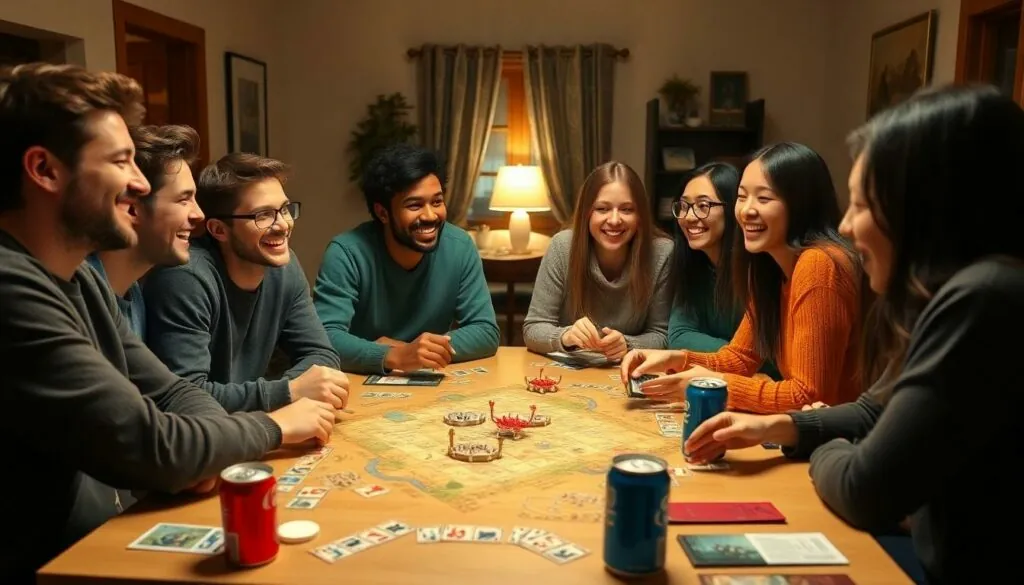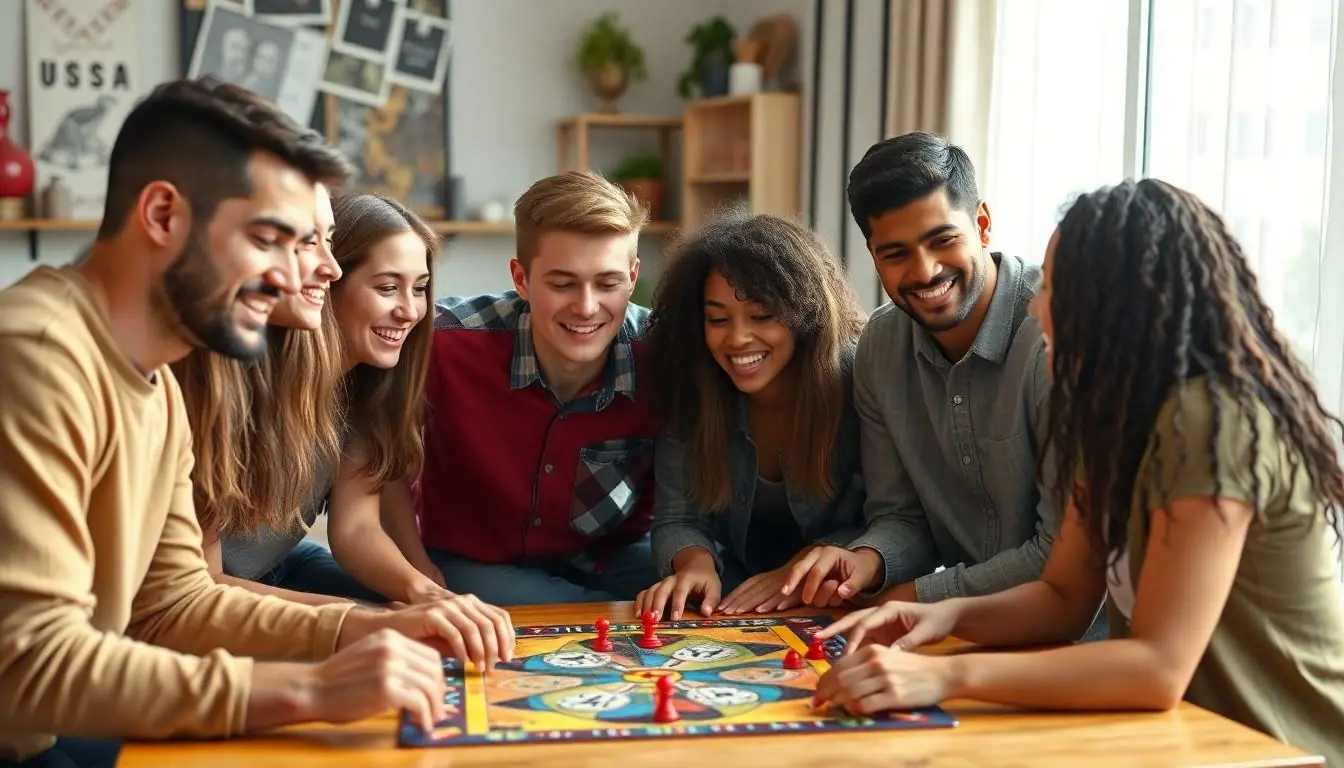Table of Contents
ToggleTeenagers often find themselves caught in a whirlwind of social media, video games, and endless scrolling. But what if there’s a way to break free from the screen and unleash their inner champions? Indoor games for teenagers offer the perfect blend of fun, competition, and a dash of friendly rivalry.
Overview of Indoor Games for Teenagers
Indoor games offer numerous benefits for teenagers seeking a break from their screens. They promote social interaction and physical activity, fostering teamwork and communication skills. Board games, card games, and video games serve as engaging alternatives that entertain and challenge young minds.
Board games like Monopoly and Settlers of Catan encourage strategic thinking and planning. Card games such as Uno and Poker allow for friendly competition and quick decision-making. These games often involve groups, enhancing social bonds among peers.
Moreover, video games that support multiplayer modes engage teenagers in cooperative play. Titles like Mario Kart and Fortnite provide a platform for teamwork and friendly rivalry. Through these games, teens develop skills in problem-solving, reflexes, and coordination.
Consider table tennis. This indoor sport improves hand-eye coordination while promoting physical fitness. It balances competition and exercise, making it a popular choice among teenagers.
Another option is indoor rock climbing. This activity challenges strength and mental resilience. Climbing gyms offer spaces for teens to push their limits while cultivating perseverance.
Escape rooms also present unique scenarios for teenagers to solve puzzles and work collaboratively. These experiences enhance critical thinking and creativity, making them a thrilling option.
Ultimately, indoor games for teenagers combine fun and learning. They allow teens to hone essential life skills and enjoy quality time with friends while stepping away from screens.
Popular Indoor Games
Indoor games offer variety for teenagers looking for engaging alternatives to screens. From strategic challenges to fast-paced fun, several options cater to different interests.
Board Games
Board games stand out by encouraging strategic thinking and social interaction. Monopoly challenges players to manage finances while engaging in friendly competition. Settlers of Catan promotes negotiation and resource management skills. Classic games like Scrabble enhance vocabulary and spelling in a fun context. These games create opportunities for teamwork, making them a great choice for group gatherings.
Digital Games
Digital games engage teenagers through interactive, multiplayer experiences. Titles like Fortnite promote teamwork as players work together to achieve common goals. Mario Kart makes racing exciting and encourages quick reflexes and strategic item use. Other popular options include Minecraft, fostering creativity by allowing players to build and explore worlds. Multiplayer experiences in digital games develop problem-solving skills while keeping players entertained.
Card Games
Card games offer portable fun and quick gameplay ideal for group interactions. Uno challenges players’ strategic thinking as they aim to match colors and numbers. Poker enhances decision-making and bluffing skills, providing a blend of strategy and luck. Other card games like Rummy and Spades improve critical thinking and planning abilities. These games can also be played with a simple deck of cards, making them accessible for any occasion.
Benefits of Indoor Games for Teenagers
Indoor games deliver various advantages that positively impact teenagers in multiple areas of their lives.
Social Interaction
Engagement in indoor games fosters social interaction among teenagers. Playing board games like Settlers of Catan promotes teamwork as players strategize together. Card games such as Uno create opportunities for healthy competition, allowing teens to bond over shared experiences. Additionally, multiplayer video games enhance communication skills through collaborative efforts in gameplay. Real-time discussions during gameplay encourage friendships and strengthen social connections. This combination of competition and camaraderie not only boosts their social circles but also helps them develop essential interpersonal skills.
Cognitive Development
Indoor games significantly contribute to cognitive development in teenagers. Strategy-focused activities such as chess and Monopoly challenge players to think critically and plan ahead. The decision-making involved in card games enhances quick thinking and adaptability. Problem-solving skills sharpen during cooperative gameplay in video games like Fortnite and Mario Kart, where teens must work together to overcome challenges. Regular engagement in these games also stimulates creativity, pushing them to devise innovative solutions. Overall, indoor games serve as a fun and effective way for teenagers to cultivate their intellectual abilities.
Physical Activity
Participation in indoor games supports physical activity essential for teenage health. Activities like table tennis require coordination and reflexes, promoting agility and fitness. Indoor rock climbing offers an exciting alternative, focusing on strength and endurance. Games that involve movement, such as charades, engage their bodies while fostering creativity. Short, active indoor games can be easily incorporated into daily routines, keeping teens physically engaged even during inclement weather. By enjoying these activities, teenagers develop healthy habits that contribute to overall well-being.
Tips for Choosing Indoor Games
Choosing the right indoor games for teenagers involves understanding preferences and dynamics. Several factors play into effective game selection.
Consider Age and Interests
Age significantly influences preferences. Different age groups enjoy varying levels of complexity and engagement. Younger teens might appreciate fast-paced games that spark excitement, such as Uno. In contrast, older teens may lean toward strategy-based games like Settlers of Catan, which require deeper thinking. Interests also play a role; some teens prefer competitive games while others enjoy cooperative experiences. Engaging with the players ensures the game resonates with interests, making it more enjoyable.
Group Dynamics
Group dynamics impact game selection. Size of the group influences whether a game works well for everyone. Larger groups benefit from games that accommodate multiple players, such as Mafia or charades. Smaller groups might appreciate more intimate gameplay, like card games or board games focused on two to four players. Personality types within the group also matter—outgoing teens may thrive in social games while introverted teens might prefer strategy games requiring less interaction. Fostering an inclusive environment encourages all players to join in and enjoy the experience.
Conclusion
Indoor games serve as a fantastic outlet for teenagers looking to balance screen time with engaging activities. They not only provide a break from digital distractions but also promote essential life skills. Through these games, teens can enhance their social interactions and physical fitness while developing critical thinking and teamwork abilities.
Choosing the right indoor game can make all the difference in creating memorable experiences. By considering preferences and group dynamics, teens can find games that resonate with their interests. Ultimately, indoor games offer a perfect blend of fun and learning, making them an invaluable addition to any teenager’s routine.








